
 |
||||||
|
GAY
FILM REVIEWS BY MICHAEL D. KLEMM
|
||||||
|
Sebastiane Kino
Video,
Directors/Screenplay: Starring: Unrated, 85 minutes
Caravaggio Zeitgeist Video, Director/Screenplay:
Starring: Unrated, 93 minutes
Edward II Image
Entertainment, Director:
Screenplay:
Starring:
Unrated, 90 minutes |
Three
Films By
The late artist, Derek Jarman, is famed for his many provocative, controversial and confrontational contributions to modern queer cinema. Jarman enjoyed renown as a painter and as a set designer (he worked on Ken Russell's 1971 film The Devils) before turning to filmmaking. Jarman left behind a large body of work which, along with his art, his books and his films, also includes videos for The Smiths and The Pet Shop Boys. The experimental, personal, and sometimes shocking nature of his cinema was more important to the artist than mainstream success and the iconoclastic Jarman was a fierce critic of Margaret Thatcher's England, his name synonymous with rebellion. Always the champion of gay rights, the anger in his cinema grew more evident after he made public his diagnosis with AIDS in 1986. He succumbed to the disease in 1994, his last film being the somber and reflective Blue (1993). Jarman's cinema broke a lot of taboos, one of them being unprecedented celebrations of gay sexuality. Nowhere is this more apparent than in his first feature film, co-directed with Paul Humfress, Sebastiane (1976). This retelling of the doomed saint's fate, re-imagined through a queer lens, is unlike anything ever screened in Sunday school. |
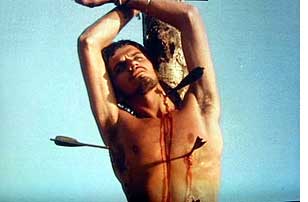 Depictions
of the martyrdom of St. Sebastian are the most homoerotic images in all
of Christian art. St. Sebastian has often been called the first gay icon.
He is usually painted in a pose of submission, hands tied behind his back,
or over his head, to a pole or a tree, wearing nothing but a loin cloth.
His body is pierced with symbolic penetrating arrows and his expression
is rapturous as he seems to bask in the pleasures of his own martyrdom.
He is always young and muscular and beautiful. This brings to mind gay comic
Bob Smith's classic joke about all the gay Renaissance painters meeting
at a party and one of them saying that he has a great idea: "Let's paint
some pictures of hot naked men and sell them to churches. Wouldn't that
be a hoot?" Depictions
of the martyrdom of St. Sebastian are the most homoerotic images in all
of Christian art. St. Sebastian has often been called the first gay icon.
He is usually painted in a pose of submission, hands tied behind his back,
or over his head, to a pole or a tree, wearing nothing but a loin cloth.
His body is pierced with symbolic penetrating arrows and his expression
is rapturous as he seems to bask in the pleasures of his own martyrdom.
He is always young and muscular and beautiful. This brings to mind gay comic
Bob Smith's classic joke about all the gay Renaissance painters meeting
at a party and one of them saying that he has a great idea: "Let's paint
some pictures of hot naked men and sell them to churches. Wouldn't that
be a hoot?" |
|
|
|
|
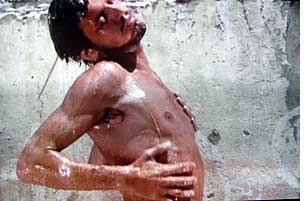 Sebastian
(Leonardo Treviglio), a Captain of the Guard, is one of Emperor Diocletian's
favorites. They greet at the banquet with a very sensual kiss on the mouth.
When a Christian is killed as part of the evening's entertainment, Sebastian
intervenes and the angry Emperor strips Sebastian of his rank and banishes
him as a common soldier. Exiled from Rome, Sebastian practices pointless
daily maneuvers with his fellow soldiers at a remote outpost under the ever-watchful
eyes of Severus, their Captain. Severus (Barney James) lusts after Sebastian
and, when his advances are rebuffed, he orders the young man's execution.
Sebastian is tied to a post and shot with arrows to fulfill his iconic martyrdom.
The film deviates from the established canon. In the traditional story,
St. Sebastian was sentenced to death by archers at the Emperor's
order (again, for displaying Christian sympathies) but he survived the ordeal
and is said to have performed several miracles before Diocletian had him
executed a second time, this time being beaten to death and his body thrown
into a sewer. Sebastian
(Leonardo Treviglio), a Captain of the Guard, is one of Emperor Diocletian's
favorites. They greet at the banquet with a very sensual kiss on the mouth.
When a Christian is killed as part of the evening's entertainment, Sebastian
intervenes and the angry Emperor strips Sebastian of his rank and banishes
him as a common soldier. Exiled from Rome, Sebastian practices pointless
daily maneuvers with his fellow soldiers at a remote outpost under the ever-watchful
eyes of Severus, their Captain. Severus (Barney James) lusts after Sebastian
and, when his advances are rebuffed, he orders the young man's execution.
Sebastian is tied to a post and shot with arrows to fulfill his iconic martyrdom.
The film deviates from the established canon. In the traditional story,
St. Sebastian was sentenced to death by archers at the Emperor's
order (again, for displaying Christian sympathies) but he survived the ordeal
and is said to have performed several miracles before Diocletian had him
executed a second time, this time being beaten to death and his body thrown
into a sewer. |
|
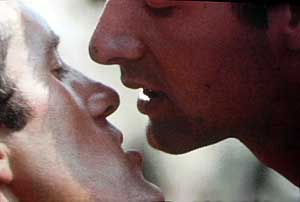 It's
difficult to pinpoint exactly what Jarman's aims were in making this film
(Tony Peake, his biographer, reports Jarman's obsession with St. Sebastian's
image during his time at art school) but, nevertheless, Sebastiane
is notable for many reasons. It was the first feature to ever be filmed
entirely in Latin, pre-dating Mel Gibson's torture-porn epic The Passion
Of The Christ by almost 30 years. It was also the first homoerotic British
film and it ushered in a new era, paving the way for later efforts like
Ron Peck's 1978 Nighthawks.
Gay audiences in 1976 were undoubtedly stunned by the daring images that
saturated Jarman's screen. Given the time, being the first to so explicitly
depict desire between men was surely one of the filmmakers' intentions. It's
difficult to pinpoint exactly what Jarman's aims were in making this film
(Tony Peake, his biographer, reports Jarman's obsession with St. Sebastian's
image during his time at art school) but, nevertheless, Sebastiane
is notable for many reasons. It was the first feature to ever be filmed
entirely in Latin, pre-dating Mel Gibson's torture-porn epic The Passion
Of The Christ by almost 30 years. It was also the first homoerotic British
film and it ushered in a new era, paving the way for later efforts like
Ron Peck's 1978 Nighthawks.
Gay audiences in 1976 were undoubtedly stunned by the daring images that
saturated Jarman's screen. Given the time, being the first to so explicitly
depict desire between men was surely one of the filmmakers' intentions. |
|
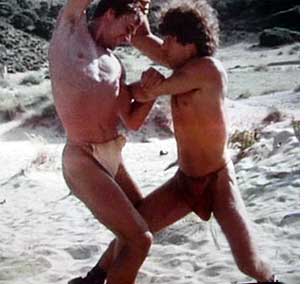 Calling
the movie "daring" is, of course, an understatement. Let me be clear that
Sebastiane is not porn
but I would be hard pressed to think of another feature film that contains
as much male frontal nudity as this one. A sizable chunk of the film's running
length features the eight muscular soldiers wearing little more than loincloths.
They practice sword fighting, they wrestle, they bathe, they engage in all
sorts of erotic horseplay. There is a long sensual interlude between two
beautiful men named Anthony and Adrian, some of it in slow motion, that
lasts for almost seven minutes. Their kisses, in tight close-up, are the
sexiest I have ever seen in any movie. Calling
the movie "daring" is, of course, an understatement. Let me be clear that
Sebastiane is not porn
but I would be hard pressed to think of another feature film that contains
as much male frontal nudity as this one. A sizable chunk of the film's running
length features the eight muscular soldiers wearing little more than loincloths.
They practice sword fighting, they wrestle, they bathe, they engage in all
sorts of erotic horseplay. There is a long sensual interlude between two
beautiful men named Anthony and Adrian, some of it in slow motion, that
lasts for almost seven minutes. Their kisses, in tight close-up, are the
sexiest I have ever seen in any movie. |
|
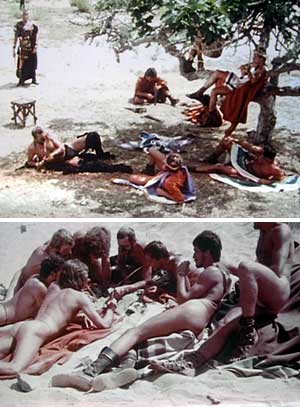 Yet
none of this seems gratuitous. The camaraderie between these men is very
believable. Their scenes display a gritty realism that is light years ahead
of those cheesy Sword and Sandal epics that proliferated in the late 50s
and early 60s, not to mention the unintentional camp of Cecil B. DeMille's
The Ten Commandments. Despite a low budget,
Sebastiane is filmed with an eye towards the painterly image.
The look of Sebastiane was greatly
influenced by the works of another pioneering gay filmmaker, Pier Paolo
Pasolini - particularly his The Gospel According To St. Matthew (1964)
and Oedipus Rex (1967). Another influence has to be Federico Fellini's
1969 film of Petronius' Satyricon but with a major difference; Fellini's
protagonists were meant to be symbolic of decadent ancient Rome whereas
Jarman was after lyricism and beauty. (Fellini, on the other hand, once
famously said that he had to cast American actors as the leads in his Satyricon
because "there are no homosexuals in Italy.") The classical groupings of
Sebastian and the archers during the film's finale are reminiscent of countless
Renaissance paintings. Yet
none of this seems gratuitous. The camaraderie between these men is very
believable. Their scenes display a gritty realism that is light years ahead
of those cheesy Sword and Sandal epics that proliferated in the late 50s
and early 60s, not to mention the unintentional camp of Cecil B. DeMille's
The Ten Commandments. Despite a low budget,
Sebastiane is filmed with an eye towards the painterly image.
The look of Sebastiane was greatly
influenced by the works of another pioneering gay filmmaker, Pier Paolo
Pasolini - particularly his The Gospel According To St. Matthew (1964)
and Oedipus Rex (1967). Another influence has to be Federico Fellini's
1969 film of Petronius' Satyricon but with a major difference; Fellini's
protagonists were meant to be symbolic of decadent ancient Rome whereas
Jarman was after lyricism and beauty. (Fellini, on the other hand, once
famously said that he had to cast American actors as the leads in his Satyricon
because "there are no homosexuals in Italy.") The classical groupings of
Sebastian and the archers during the film's finale are reminiscent of countless
Renaissance paintings. |
|
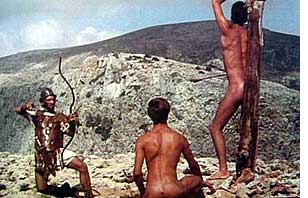 Jarman's
Sebastian is an outsider in his regiment because of his status as a Christian.
(The Religious Right should embrace the film for this reason but we know
that isn't going to happen.) Christianity becomes a substitute for homosexuality;
Max (Neil Kennedy), the most rugged and swaggeringly macho of the soldiers,
harasses Sebastian for his religious beliefs and it would be easy to re-cast
him in the role of a gay basher in a more contemporary film. Despite Max's
yearnings for a good harlot when he returns to Rome, and his comment that
Greeks are only good for a "quick one," homosexuality does not seem to be
an issue with these men. Anthony and Adrian (Janusz Romanov and Ken Hicks)
are gently teased for their affections towards each other yet their proclivities
are seen as neither feminine nor as signs of weakness. The soldiers are
obsessed with their penises. Max is fond of dancing around sporting a golden
phallic codpiece; he will wear it proudly when he shoots his arrow at Sebastian. Jarman's
Sebastian is an outsider in his regiment because of his status as a Christian.
(The Religious Right should embrace the film for this reason but we know
that isn't going to happen.) Christianity becomes a substitute for homosexuality;
Max (Neil Kennedy), the most rugged and swaggeringly macho of the soldiers,
harasses Sebastian for his religious beliefs and it would be easy to re-cast
him in the role of a gay basher in a more contemporary film. Despite Max's
yearnings for a good harlot when he returns to Rome, and his comment that
Greeks are only good for a "quick one," homosexuality does not seem to be
an issue with these men. Anthony and Adrian (Janusz Romanov and Ken Hicks)
are gently teased for their affections towards each other yet their proclivities
are seen as neither feminine nor as signs of weakness. The soldiers are
obsessed with their penises. Max is fond of dancing around sporting a golden
phallic codpiece; he will wear it proudly when he shoots his arrow at Sebastian. |
|
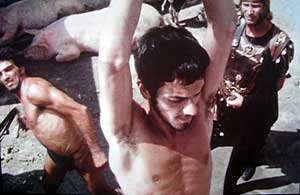 The
film is an odd hybrid of the St, Sebastian legend and Herman Melville's
Billy Budd - with Sebastian as the angelic sailor. His superior,
Severus, doubles as the sadistic Master at Arms, John Claggart, whose hatred
for Budd was a mask for his forbidden desire. (Claire Denis's 1999 Beau
Travail is in many ways almost the same film except that the evil officer
and the homoerotic esprit de corps are transposed to the French Foreign
Legion.) Severus is clearly aroused by Sebastian, as is apparent in a lengthy
early interlude in which he watches from a distance as the young man bathes.
When Sebastian throws down his arms and refuses to fight, Severus has him
whipped - the first of several sado-masochistic scenes that break the otherwise
idyllic air. Some of these scenes are a bit rough. When Severus' lust finally
gets the best of him, he plants his boot on Sebastian's neck and shouts
"Ask for it, you Christian whore!" It seems, however, that Sebastian enjoys
- or at least accepts - his role as a submissive when he muses that
"his punishments are like Christ's promise. He takes me in his arm and caresses
my bleeding body. I want to be with him. I love him." The
film is an odd hybrid of the St, Sebastian legend and Herman Melville's
Billy Budd - with Sebastian as the angelic sailor. His superior,
Severus, doubles as the sadistic Master at Arms, John Claggart, whose hatred
for Budd was a mask for his forbidden desire. (Claire Denis's 1999 Beau
Travail is in many ways almost the same film except that the evil officer
and the homoerotic esprit de corps are transposed to the French Foreign
Legion.) Severus is clearly aroused by Sebastian, as is apparent in a lengthy
early interlude in which he watches from a distance as the young man bathes.
When Sebastian throws down his arms and refuses to fight, Severus has him
whipped - the first of several sado-masochistic scenes that break the otherwise
idyllic air. Some of these scenes are a bit rough. When Severus' lust finally
gets the best of him, he plants his boot on Sebastian's neck and shouts
"Ask for it, you Christian whore!" It seems, however, that Sebastian enjoys
- or at least accepts - his role as a submissive when he muses that
"his punishments are like Christ's promise. He takes me in his arm and caresses
my bleeding body. I want to be with him. I love him." |
|
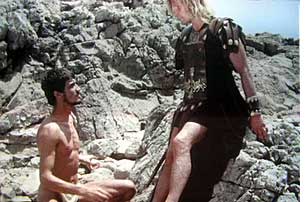 One
might think, from these descriptions, that Sebastiane
is a humorless film but this is not the case. A few paragraphs back, I referenced
DeMille and Fellini. Jarman adds a very funny scene, rife with cinematic
in-jokes, in which Max longs for the good old days when Christians were
thrown to the lions, the Coliseum hosted the chariot races of "Cecilli Mille,
the director from Silva Sacra" and "Philistini scoured all the brothels
of Rome...looking for pretty boys for his production of Satyricon."
The screenwriter who translated the script into Latin indulged in a few
private jokes of his own - a subtitle that reads "Come on motherfucker"
is accompanied by a Latin phrase that sounds like "Okay Oedipus." Jarman
also throws in an amusing homage to Kenneth Anger's classic Fireworks
(1947) when a phallic fertility dance at the Emperor's palace ends with
a close-up of the lead dancer's painted face being splattered with white
paste. One
might think, from these descriptions, that Sebastiane
is a humorless film but this is not the case. A few paragraphs back, I referenced
DeMille and Fellini. Jarman adds a very funny scene, rife with cinematic
in-jokes, in which Max longs for the good old days when Christians were
thrown to the lions, the Coliseum hosted the chariot races of "Cecilli Mille,
the director from Silva Sacra" and "Philistini scoured all the brothels
of Rome...looking for pretty boys for his production of Satyricon."
The screenwriter who translated the script into Latin indulged in a few
private jokes of his own - a subtitle that reads "Come on motherfucker"
is accompanied by a Latin phrase that sounds like "Okay Oedipus." Jarman
also throws in an amusing homage to Kenneth Anger's classic Fireworks
(1947) when a phallic fertility dance at the Emperor's palace ends with
a close-up of the lead dancer's painted face being splattered with white
paste. |
|
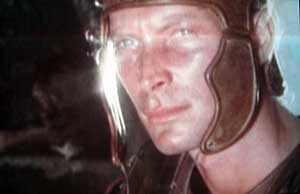 Sebastiane
defies description, it just has to be experienced. If you are one of those
guys who watched Beau Travail just for the scenery, you'll find much
to enjoy in this one too. I'd like to make one last observation on
the film's artistry. Fans of Brian Eno's music will be interested to know
that he wrote the film's understated score. The music is effective but used
sparingly; oftentimes there is only the sound of wind in the background.
I offer this as a lesson to the many modern queer filmmakers who insist
on using bad, and inappropriate, music and lame pop songs in their movies.
Consider the simple beauty of silence as an aesthetic choice. Sebastiane
defies description, it just has to be experienced. If you are one of those
guys who watched Beau Travail just for the scenery, you'll find much
to enjoy in this one too. I'd like to make one last observation on
the film's artistry. Fans of Brian Eno's music will be interested to know
that he wrote the film's understated score. The music is effective but used
sparingly; oftentimes there is only the sound of wind in the background.
I offer this as a lesson to the many modern queer filmmakers who insist
on using bad, and inappropriate, music and lame pop songs in their movies.
Consider the simple beauty of silence as an aesthetic choice. |
|
|
|
|
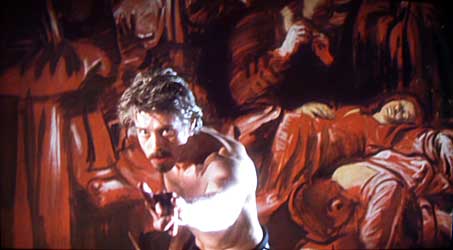 |
|
| Michelangelo Merisi da Caravaggio (1571-1610) was an Italian painter, widely recognized as the first great Baroque artist. Caravaggio's paintings are noted for his dramatic use of light and shadow (pre-dating Rembrandt by several decades), for his unprecedented realism, and for his controversial use of street urchins and prostitutes as models for religious subjects. He was a notorious street brawler and often fell afoul with the law; he even killed a man once. Art scholars debate the painter's sexuality but the homoerotism inherent in Caravaggio's male figures should be obvious even to anyone who doesn't view them through a lavender lens. | |
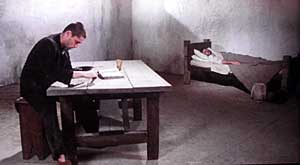 The
revered artist's status as an outsider is, no doubt, one of the things that
attracted Caravaggio as a cinematic subject to the idiosyncratic filmmaker.
After making Sebastiane, Derek
Jarman filmed Jubilee (1977), a popular, punk post-apocalyptic flick
featuring a 1970s English wasteland visited by Queen Elizabeth II. (It is,
to many, a cult classic.) A modernist and free adaptation of Shakespeare's
The Tempest followed in 1979. For the next few years, Jarman dabbled
in experimental shorts before returning to the feature format in 1985 with
The Angelic Conversation. This poetic and meditative film mixed homoerotic
imagery with a soundtrack consisting of Shakespeare's Sonnets read by none
other than famed actress Judi Densch. The
revered artist's status as an outsider is, no doubt, one of the things that
attracted Caravaggio as a cinematic subject to the idiosyncratic filmmaker.
After making Sebastiane, Derek
Jarman filmed Jubilee (1977), a popular, punk post-apocalyptic flick
featuring a 1970s English wasteland visited by Queen Elizabeth II. (It is,
to many, a cult classic.) A modernist and free adaptation of Shakespeare's
The Tempest followed in 1979. For the next few years, Jarman dabbled
in experimental shorts before returning to the feature format in 1985 with
The Angelic Conversation. This poetic and meditative film mixed homoerotic
imagery with a soundtrack consisting of Shakespeare's Sonnets read by none
other than famed actress Judi Densch. |
|
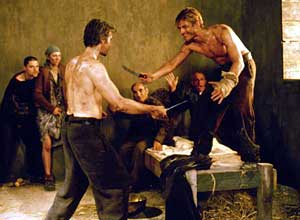 The
long germinating Caravaggio bore
fruit in 1986. Jarman's Caravaggio
is a fictionalized portrait of the artist as a young rogue. Jarman has written
that his portrait is "based on a reading of the paintings." This is not
a traditional narrative, but a series of impressions; like an artist's sketchbook.
The painter (Nigel Terry) lies on his deathbed in the film's framing story,
tended by his mute servant, and his life is told through a series of feverish,
and perhaps unreliable, flashbacks. One of the first shows him as an adolescent
being rescued from a life of street painting and hustling by his lifelong
patron, Cardinal Del Monte. His sporadic memories lead the viewer through
a streams of disconnected sketches... the artist at work, drunken bar brawls,
an awkward audience with the Pope. The
long germinating Caravaggio bore
fruit in 1986. Jarman's Caravaggio
is a fictionalized portrait of the artist as a young rogue. Jarman has written
that his portrait is "based on a reading of the paintings." This is not
a traditional narrative, but a series of impressions; like an artist's sketchbook.
The painter (Nigel Terry) lies on his deathbed in the film's framing story,
tended by his mute servant, and his life is told through a series of feverish,
and perhaps unreliable, flashbacks. One of the first shows him as an adolescent
being rescued from a life of street painting and hustling by his lifelong
patron, Cardinal Del Monte. His sporadic memories lead the viewer through
a streams of disconnected sketches... the artist at work, drunken bar brawls,
an awkward audience with the Pope. |
|
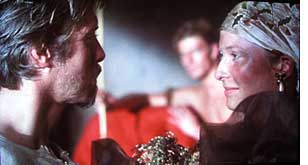 A
love triangle dominates his thoughts. This triad consists of himself, a
feral streetfighter named Ranuccio (a very young Sean Bean) and his mistress,
the prostitute Lena (Tilda Swinton in her first film appearance.) Caravaggio's
sexual appetite is reserved for Ranuccio though Lena benefits from his attentions
as well. Both will serve as models for his best known canvasses. To symbolize
their complicated relationship, Jarman often photographs the trio in triangular
compositions. Both Caravaggio and Ranuccio are violent men yet a strange
bond grows between them. A shirtless brawl ends with Ranuccio deliberately
cutting Caravaggio with a knife. The artist responds by rubbing the blood
in his model's face and proclaiming him "blood brother." Later, when Caravaggio
cuts Ranuccio's throat, the process is reversed. A
love triangle dominates his thoughts. This triad consists of himself, a
feral streetfighter named Ranuccio (a very young Sean Bean) and his mistress,
the prostitute Lena (Tilda Swinton in her first film appearance.) Caravaggio's
sexual appetite is reserved for Ranuccio though Lena benefits from his attentions
as well. Both will serve as models for his best known canvasses. To symbolize
their complicated relationship, Jarman often photographs the trio in triangular
compositions. Both Caravaggio and Ranuccio are violent men yet a strange
bond grows between them. A shirtless brawl ends with Ranuccio deliberately
cutting Caravaggio with a knife. The artist responds by rubbing the blood
in his model's face and proclaiming him "blood brother." Later, when Caravaggio
cuts Ranuccio's throat, the process is reversed. |
|
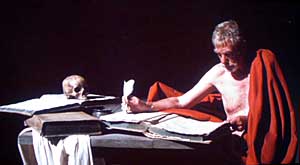 The
film's genesis lay in a collaboration between Jarman and an important art
dealer named Nicholas Ward-Jackson. The arts patron wanted a gay filmmaker
to realize his pet film project about Caravaggio and his dreams of working
with Pasolini were dashed when the controversial director was brutally murdered
by a hustler in 1975. Upon seeing Sebastiane,
Ward-Jackson deemed Jarman to be a suitable replacement.
It was important to both that the artist's sexuality and his notorious volatility
find expression in the finished film. Jarman was once again intrigued by
the idea of juxtaposing the sacred and the profane. The
film's genesis lay in a collaboration between Jarman and an important art
dealer named Nicholas Ward-Jackson. The arts patron wanted a gay filmmaker
to realize his pet film project about Caravaggio and his dreams of working
with Pasolini were dashed when the controversial director was brutally murdered
by a hustler in 1975. Upon seeing Sebastiane,
Ward-Jackson deemed Jarman to be a suitable replacement.
It was important to both that the artist's sexuality and his notorious volatility
find expression in the finished film. Jarman was once again intrigued by
the idea of juxtaposing the sacred and the profane. |
|
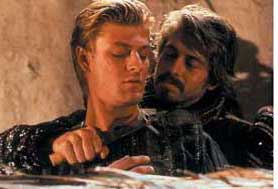 Jarman
detested commercial filmmaking; he once said that he doesn't make movies,
he makes moving pictures. If you're looking for a history lesson
about the artist, you've come to the wrong film. Prior knowledge of the
artist is almost a prerequisite and impatient viewers will probably find
Caravaggio chaotic. Unlike Milos
Forman's delightful Amadeus, Caravaggio
is not blessed with a clever and witty script by the likes of playwright
Peter Schafer. At the same time, it is also a far cry from a stuffy and
schlocky Hollywood bio-pic like The Agony and the Ecstasy (with Charlton
Heston as Michelangelo. Yikes!!!). Caravaggio's
brilliance lies not in its words but in its imagery. The film's cinematography
resembles a Caravaggio canvas. Jarman
detested commercial filmmaking; he once said that he doesn't make movies,
he makes moving pictures. If you're looking for a history lesson
about the artist, you've come to the wrong film. Prior knowledge of the
artist is almost a prerequisite and impatient viewers will probably find
Caravaggio chaotic. Unlike Milos
Forman's delightful Amadeus, Caravaggio
is not blessed with a clever and witty script by the likes of playwright
Peter Schafer. At the same time, it is also a far cry from a stuffy and
schlocky Hollywood bio-pic like The Agony and the Ecstasy (with Charlton
Heston as Michelangelo. Yikes!!!). Caravaggio's
brilliance lies not in its words but in its imagery. The film's cinematography
resembles a Caravaggio canvas. |
|
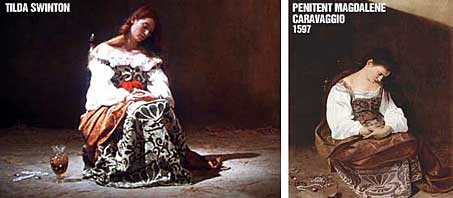 |
|
| This method might hold more interest to art students but the re-creations of Caravaggio's paintings are wondrous to behold - especially the recognizable tableaus of Ranuccio posing as John the Baptist and Lena as Mary Magdalene. (One of Jarman's contemporaries, director John Maybury, would take a similar approach in his very queer 1998 film about painter Francis Bacon, Love Is The Devil.) Art Director Christopher Hobbs did a magnificent job painting the full sized Caravaggio copies - both finished and in-progress. If this art lesson isn't your cup of tea, the erotic aspects of the art studio scenes can be enjoyed in their own right. How about Ranuccio posing almost naked with a sword? The artist handles him roughly as he positions the arm and the shoulder and then, from his easel, throws gold coins to his model - who suggestively inserts the coins into his mouth. Ranuccio takes the last coin directly from the artist's lips. Later, following the foreplay of their knife brawl, they kiss ferociously and Lena angrily accuses her man of being a "rent boy." | |
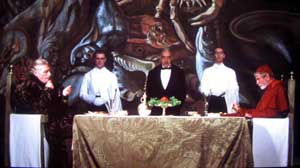 Did
I just say that she calls him a "rent boy?" This brings us to Jarman's
unique use of anachronism. Modern props share the stage with 17th century
settings to uniquely comment on the art scene and politics of Jarman's day.
This doesn't mean that Caravaggio
is like one of those cheesy films where a Roman solider is wearing a wristwatch,
or an oil tanker sails by on the horizon in a bad viking epic. I refer to
a grand tradition that includes Orson Welles' famed 1930s modern dress Julius
Caesar set in fascist Italy, and the real Caravaggio's own practice
of painting religious figures in contemporary clothing. In Jarman's alternate
universe, Caravaggio and his friends smoke cigarettes, Ranuccio owns a motorbike,
a banker uses an electronic calculator, there are waiters wearing tuxedos
in a restaurant. These jarring elements blur the present and the past. Did
I just say that she calls him a "rent boy?" This brings us to Jarman's
unique use of anachronism. Modern props share the stage with 17th century
settings to uniquely comment on the art scene and politics of Jarman's day.
This doesn't mean that Caravaggio
is like one of those cheesy films where a Roman solider is wearing a wristwatch,
or an oil tanker sails by on the horizon in a bad viking epic. I refer to
a grand tradition that includes Orson Welles' famed 1930s modern dress Julius
Caesar set in fascist Italy, and the real Caravaggio's own practice
of painting religious figures in contemporary clothing. In Jarman's alternate
universe, Caravaggio and his friends smoke cigarettes, Ranuccio owns a motorbike,
a banker uses an electronic calculator, there are waiters wearing tuxedos
in a restaurant. These jarring elements blur the present and the past. |
|
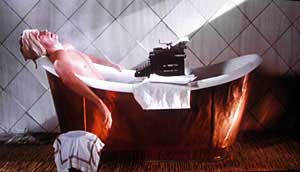 The
best example of this unconventional method (which also manages at the same
time to reference and parody two well known iconic images) involves a snooty
art critic. He writes a pompous and scathing review of Caravaggio's art
on a typewriter while laying in a bathtub like the evil columnist
Waldo Lydecker in the old 1944 film noir, Laura. Then he sinks down
in the tub until the image resembles Jacques-Louis David's famous 1793 painting
The Death of Marat. The double reference also makes explicit a link
between the canvas and cinema. Jarman the artist is having a lot of visual
fun in his film. He even begins it with a hand painting one coat of black
paint after another across the screen, in opposite directions, behind the
opening credits. In Hitchcock
fashion, Jarman makes his cameo as a priest in the Pope's entourage. The
best example of this unconventional method (which also manages at the same
time to reference and parody two well known iconic images) involves a snooty
art critic. He writes a pompous and scathing review of Caravaggio's art
on a typewriter while laying in a bathtub like the evil columnist
Waldo Lydecker in the old 1944 film noir, Laura. Then he sinks down
in the tub until the image resembles Jacques-Louis David's famous 1793 painting
The Death of Marat. The double reference also makes explicit a link
between the canvas and cinema. Jarman the artist is having a lot of visual
fun in his film. He even begins it with a hand painting one coat of black
paint after another across the screen, in opposite directions, behind the
opening credits. In Hitchcock
fashion, Jarman makes his cameo as a priest in the Pope's entourage. |
|
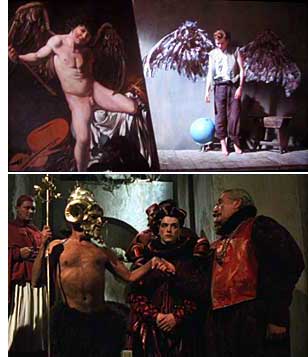 I'll
be honest, at times Caravaggio
may get on the average viewer's nerves but it isn't all academic and the
film is often quite funny. A party for the unveiling of a privately commissioned
painting is the one of the film's highlights. Jarman's description of Sebastiane's
"cruel cocktail party where the glitterati met Oriental Rome" is recalled
again here. This gala, with jazz music in the background, in set in the
catacombs. Everyone who is anybody in Rome is there, including the Pope.
A daffy society lady, when introduced to Michelangelo Caravaggio, exclaims
"Michelangelo! You're not related, are you?" His canvas, Profane
Love, is unveiled to much applause. The art critic calls it ugly but
loves the frame. Caravaggio and Ranuccio steal a kiss in the tombs. Lena,
stunningly dressed, lands a big fish and sneaks away from the party with
Cardinal Scipione, the Pope's nephew. In private, he pulls off his fake
moustache ("The agonies of fashion," he moans), kisses her feet,
and calls her "Madonna, Queen of Heaven." I'll
be honest, at times Caravaggio
may get on the average viewer's nerves but it isn't all academic and the
film is often quite funny. A party for the unveiling of a privately commissioned
painting is the one of the film's highlights. Jarman's description of Sebastiane's
"cruel cocktail party where the glitterati met Oriental Rome" is recalled
again here. This gala, with jazz music in the background, in set in the
catacombs. Everyone who is anybody in Rome is there, including the Pope.
A daffy society lady, when introduced to Michelangelo Caravaggio, exclaims
"Michelangelo! You're not related, are you?" His canvas, Profane
Love, is unveiled to much applause. The art critic calls it ugly but
loves the frame. Caravaggio and Ranuccio steal a kiss in the tombs. Lena,
stunningly dressed, lands a big fish and sneaks away from the party with
Cardinal Scipione, the Pope's nephew. In private, he pulls off his fake
moustache ("The agonies of fashion," he moans), kisses her feet,
and calls her "Madonna, Queen of Heaven." |
|
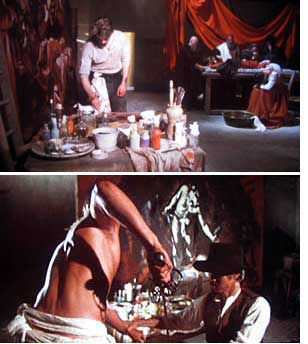 The
role of the church in Caravaggio
is important. The widespread corruption of the period is well known. The
critic, while panning Caravaggio's art, will refer to a "conspiracy between
church and gutter." The Pope will say to Caravaggio, "I hear you're a bit
of a rascal. One of the family" and then remarks that "Revolutionary
gestures in art can be a great help to us. Keeps the quo in the status."
Mirroring the hypocrisy of so many religious figures today, Cardinal Del
Monte clearly desires Caravaggio and the artist's commission to paint Profane
Love comes from a member of Del Monte's inner circle. Lena will be murdered
after becoming pregnant with Cardinal Scipione's child, and Caravaggio uses
her corpse as the central figure in his Death Of The Virgin. The
role of the church in Caravaggio
is important. The widespread corruption of the period is well known. The
critic, while panning Caravaggio's art, will refer to a "conspiracy between
church and gutter." The Pope will say to Caravaggio, "I hear you're a bit
of a rascal. One of the family" and then remarks that "Revolutionary
gestures in art can be a great help to us. Keeps the quo in the status."
Mirroring the hypocrisy of so many religious figures today, Cardinal Del
Monte clearly desires Caravaggio and the artist's commission to paint Profane
Love comes from a member of Del Monte's inner circle. Lena will be murdered
after becoming pregnant with Cardinal Scipione's child, and Caravaggio uses
her corpse as the central figure in his Death Of The Virgin. |
|
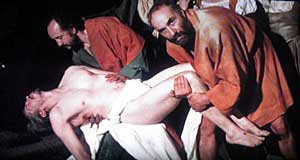 While
much of Caravaggio is fiction,
much of it is suggested by historical facts. Caravaggio did, indeed, paint
a well known prostitute as the Virgin Mary. The film's Ranuccio poses for
the painting of John the Baptist that the historical Caravaggio carried
with him, in exile, until his death. While there is no evidence for the
film's central love triangle, in 1606 he killed a man named Ranuccio Tomassoni
during a swordfight. Jarman was intrigued by Caravaggio's signature on the
canvas he painted soon afterwards, The Beheading Of John The Baptist
(the only canvas the artist ever signed). The signature reads "I Caravaggio
did this" and Jarman read this as a coded confession of murder. The director's
final visual pun places Caravaggio's dead body in a tableau that recreates
one of the artist's finest paintings, The Entombment Of Christ. While
much of Caravaggio is fiction,
much of it is suggested by historical facts. Caravaggio did, indeed, paint
a well known prostitute as the Virgin Mary. The film's Ranuccio poses for
the painting of John the Baptist that the historical Caravaggio carried
with him, in exile, until his death. While there is no evidence for the
film's central love triangle, in 1606 he killed a man named Ranuccio Tomassoni
during a swordfight. Jarman was intrigued by Caravaggio's signature on the
canvas he painted soon afterwards, The Beheading Of John The Baptist
(the only canvas the artist ever signed). The signature reads "I Caravaggio
did this" and Jarman read this as a coded confession of murder. The director's
final visual pun places Caravaggio's dead body in a tableau that recreates
one of the artist's finest paintings, The Entombment Of Christ. |
|
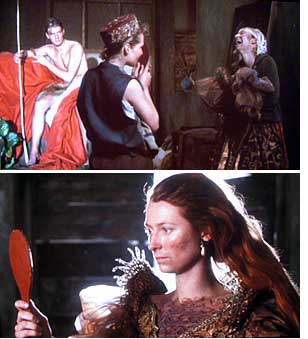 The
three lead actors are superb. Nigel Terry bears a striking resemblance to
a 1621 chalk portrait of the artist and, during one of the DVD's extras,
the actor admits to that being one of the reasons he got the part. Even
dressed in rags, Tilda Swinton is radiant in her screen debut. When Caravaggio
presents her with a gown, for the big party, she is as excited as a schoolgirl;
when she puts the dress on and brushes her hair she is transformed into
the belle of the ball and becomes the very visage of the period's portraiture.
Jarman's camera is in love with her; is it any wonder that he would cast
her in each of his remaining films? Sean Bean is the embodiment of rough
trade sexy; young, handsome and dangerous. The
three lead actors are superb. Nigel Terry bears a striking resemblance to
a 1621 chalk portrait of the artist and, during one of the DVD's extras,
the actor admits to that being one of the reasons he got the part. Even
dressed in rags, Tilda Swinton is radiant in her screen debut. When Caravaggio
presents her with a gown, for the big party, she is as excited as a schoolgirl;
when she puts the dress on and brushes her hair she is transformed into
the belle of the ball and becomes the very visage of the period's portraiture.
Jarman's camera is in love with her; is it any wonder that he would cast
her in each of his remaining films? Sean Bean is the embodiment of rough
trade sexy; young, handsome and dangerous. |
|
|
|
|
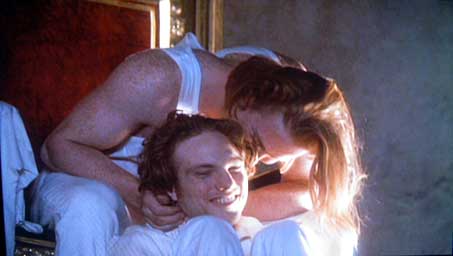 |
|
| In 1986, Derek Jarman completed Caravaggio and, later that year, learned that he was HIV positive. Unlike many of his contemporaries, (Queen's frontman, Freddie Mercury, kept his condition secret until a few days before his death), Jarman felt it was important to make his HIV status public. AIDS would increase his activism and his films grew angrier and more political. The Last Of England (1988) attacked Margaret Thatcher's England. 1989's War Requiem featured Sir Laurence Olivier in his final film appearance and reunited the three leads from Caravaggio. The Garden (1990) was filmed in the director's famous garden at his cottage by the nearby Dungeness power station. It mixed religious iconography with the story of two gay lovers cast from Eden when they are arrested, tortured and eventually killed. | |
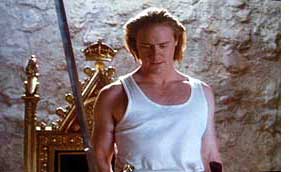 Jarman's
next film was a very queer adaptation of Christopher Marlow's classic play,
originally published in 1594, The Troublesome Reign and Lamentable Death
of Edward the Second, King of England, with the Tragical Fall of Proud Mortimer.
It is worth noting here that Marlow, like Jarman (and also Caravaggio),
was a notorious "bad boy" artist in his day. He was known for
his volativity and he was killed in a tavern brawl. Marlow is also widely
believed to have been gay. Jarman's queer activism found its loudest voice
in 1991's Edward II. Perhaps
his best known film, Edward II
was part of the watershed event that christened the "New Queer Cinema" when
it was screened at Sundance in 1992 along with Christopher Munch's The
Hours and Times, Tom Kalin's Swoon
and Greg Arraki's The Living End. Jarman's
next film was a very queer adaptation of Christopher Marlow's classic play,
originally published in 1594, The Troublesome Reign and Lamentable Death
of Edward the Second, King of England, with the Tragical Fall of Proud Mortimer.
It is worth noting here that Marlow, like Jarman (and also Caravaggio),
was a notorious "bad boy" artist in his day. He was known for
his volativity and he was killed in a tavern brawl. Marlow is also widely
believed to have been gay. Jarman's queer activism found its loudest voice
in 1991's Edward II. Perhaps
his best known film, Edward II
was part of the watershed event that christened the "New Queer Cinema" when
it was screened at Sundance in 1992 along with Christopher Munch's The
Hours and Times, Tom Kalin's Swoon
and Greg Arraki's The Living End. |
|
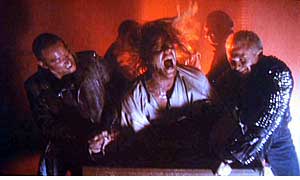 Jarman's
queer masterpiece is the historical tale of King Edward II, who ruled England
from 1307 to 1327. Most of the film's dialogue is taken directly from Marlow's
play, which described the scandalous sexual relationship between the King
(Steven Waddington) and his beloved friend, Piers Gaveston (Andrew Tiernan).
The nobility of Edward's court detest the low-born and base Gaveston, furious
that he is clearly the King's favorite. Queen Isabella (Tilda Swinton) receives
not the affections of her King and, together with the treacherous Mortimer
(Nigel Terry), plots Gaveston's exile and death. Edward's love for Gaveston
plunges the country into civil war. The King is ultimately imprisoned and
his manner of execution involved a red hot poker shoved into his rectum. Jarman's
queer masterpiece is the historical tale of King Edward II, who ruled England
from 1307 to 1327. Most of the film's dialogue is taken directly from Marlow's
play, which described the scandalous sexual relationship between the King
(Steven Waddington) and his beloved friend, Piers Gaveston (Andrew Tiernan).
The nobility of Edward's court detest the low-born and base Gaveston, furious
that he is clearly the King's favorite. Queen Isabella (Tilda Swinton) receives
not the affections of her King and, together with the treacherous Mortimer
(Nigel Terry), plots Gaveston's exile and death. Edward's love for Gaveston
plunges the country into civil war. The King is ultimately imprisoned and
his manner of execution involved a red hot poker shoved into his rectum. |
|
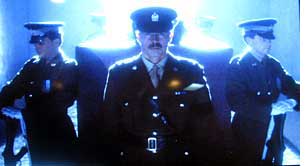 The
script, which retains Marlow's poetic language, is peppered with occasional
profanities (the F word in particular) and the action is somewhat restructured
to make it more cinematic. Edward II
begins with the King imprisoned and, like Caravaggio,
unfolds with a series of flashbacks. This approach allows Marlow's scenes
between Edward and Lightborn, his jailer and executioner, to be interspersed
and expanded upon throughout the film. Many of Edward's soliloquies are
delivered while in prison as reflections of his past woes. The play's elder
and junior Mortimers are combined into a single character. The
script, which retains Marlow's poetic language, is peppered with occasional
profanities (the F word in particular) and the action is somewhat restructured
to make it more cinematic. Edward II
begins with the King imprisoned and, like Caravaggio,
unfolds with a series of flashbacks. This approach allows Marlow's scenes
between Edward and Lightborn, his jailer and executioner, to be interspersed
and expanded upon throughout the film. Many of Edward's soliloquies are
delivered while in prison as reflections of his past woes. The play's elder
and junior Mortimers are combined into a single character. |
|
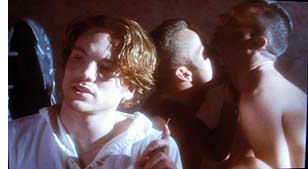 It
was important to Jarman that his Edward II
be first, and foremost, a queer film and he makes this clear almost
from the opening shot. Edward II
begins with the King, wearing rags, asleep in his prison cell. Lightborn
enters, carrying a modern nautical lantern and stoops to read the postcard
the King clutches in his hand. "Father is deceased," the card reads. "Come
Gaveston and share this kingdom with your dearest friend." The action then
cuts to the first scene in Marlow's play, wherein Gaveston reads this letter
from the King. Immediately, Jarman makes his queer intentions known as Gaveston
delivers his first soliloquy while two hunky naked men sensuously fornicate
behind him on his bed. It
was important to Jarman that his Edward II
be first, and foremost, a queer film and he makes this clear almost
from the opening shot. Edward II
begins with the King, wearing rags, asleep in his prison cell. Lightborn
enters, carrying a modern nautical lantern and stoops to read the postcard
the King clutches in his hand. "Father is deceased," the card reads. "Come
Gaveston and share this kingdom with your dearest friend." The action then
cuts to the first scene in Marlow's play, wherein Gaveston reads this letter
from the King. Immediately, Jarman makes his queer intentions known as Gaveston
delivers his first soliloquy while two hunky naked men sensuously fornicate
behind him on his bed. |
|
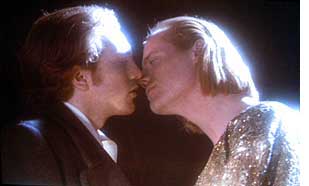 Edward
II is
filled with homoerotic imagery. Edward and Gaveston are frequently shown
kissing and sharing the same bed. The parade of male flesh includes a dancer
with a snake, a naked rugby scrum and a sweaty gymnasium. When the barons
and the clergy rebel against their King, and when Gaveston is exiled and
then later killed, Edward repeatedly whimpers like a young schoolgirl that
no one will leave him and his beloved Gaveston be. Edward
II is
filled with homoerotic imagery. Edward and Gaveston are frequently shown
kissing and sharing the same bed. The parade of male flesh includes a dancer
with a snake, a naked rugby scrum and a sweaty gymnasium. When the barons
and the clergy rebel against their King, and when Gaveston is exiled and
then later killed, Edward repeatedly whimpers like a young schoolgirl that
no one will leave him and his beloved Gaveston be. |
|
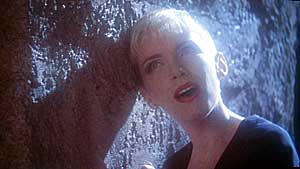 Like
Caravaggio, Edward II
is filmed on minimalist but artfully dressed stages (as, in fact, the Elizabethan
stages of both Marlow and Shakespeare would have been) and Jarman further
indulges his unique use of historical anachronisms. Edward's prison cell
is a modern steel-plated sewer. A meeting of the Nobles takes place in a
contemporary boardroom with the sounds of telephones and typewriters clattering
in the background. Most of the performers are usually wearing modern dress
and Isabella's gowns range from period Elizabethan to Coco Chanel. Edward's
son plays with a toy robot; Lightborn heats his deadly poker with a welding
torch. When Gaveston is sent into exile a second time, he shares a last
dance with the King while the gender-bending Eurythmics singer, Annie Lennox,
stands in the background and sings Cole Porter's "Everytime I Say Goodbye." Like
Caravaggio, Edward II
is filmed on minimalist but artfully dressed stages (as, in fact, the Elizabethan
stages of both Marlow and Shakespeare would have been) and Jarman further
indulges his unique use of historical anachronisms. Edward's prison cell
is a modern steel-plated sewer. A meeting of the Nobles takes place in a
contemporary boardroom with the sounds of telephones and typewriters clattering
in the background. Most of the performers are usually wearing modern dress
and Isabella's gowns range from period Elizabethan to Coco Chanel. Edward's
son plays with a toy robot; Lightborn heats his deadly poker with a welding
torch. When Gaveston is sent into exile a second time, he shares a last
dance with the King while the gender-bending Eurythmics singer, Annie Lennox,
stands in the background and sings Cole Porter's "Everytime I Say Goodbye." |
|
 Edward
II's
queerest political statement, and Jarman's most striking blur of the past
and present, occurs during the short battle scene between Edward and Mortimer's
troops. To comment on the current day, Mortimer's army consists of modern
riot police and Edward's followers are depicted as OutRage! protesters,
(England's version of ACT-UP!), holding signs with slogans such as "Gay
Desire Is Not A Crime," "Queer Is Cool" and "Get Your Filthy Laws Off Our
Bodies." The men dressed as nuns seen amongst Edward's "soldiers" are members
of that delightfully campy civil disobedience group, The Sisters Of Perpetual
Indulgence. Edward
II's
queerest political statement, and Jarman's most striking blur of the past
and present, occurs during the short battle scene between Edward and Mortimer's
troops. To comment on the current day, Mortimer's army consists of modern
riot police and Edward's followers are depicted as OutRage! protesters,
(England's version of ACT-UP!), holding signs with slogans such as "Gay
Desire Is Not A Crime," "Queer Is Cool" and "Get Your Filthy Laws Off Our
Bodies." The men dressed as nuns seen amongst Edward's "soldiers" are members
of that delightfully campy civil disobedience group, The Sisters Of Perpetual
Indulgence. |
|
|
|
|
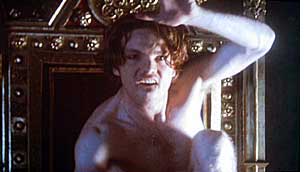 Yet
Jarman doesn't make things easy, even for his target audience, and perhaps
one of his boldest choices was to make Gaveston a thoroughly despicable
and infantile character. Yes, his love scenes with the King are very
erotic and provocative, (and will satisfy the prurient interests of
gay male viewers), yet Gaveston's behavior elsewhere makes plain the Nobility's
hatred of this man who has been elevated far above his station. The scene
in which the Bishop responsible for Gaveston's first exile suffers torture
is a thoroughly repugnant episode, and the King's boytoy couldn't be more
annoying than when he clicks his tongue and dances in his underwear on the
King's throne to mock a furious Mortimer. There is also no escaping the
fact that Jarman's Edward is, himself, a playboy who acts like a spoiled
brat when things do not go his way. Look closely, too, at the Francis
Bacon-like tableau in which one of Edward's rivals hangs crucified on
a swinging beef carcass as he awaits the King's dagger. Yet
Jarman doesn't make things easy, even for his target audience, and perhaps
one of his boldest choices was to make Gaveston a thoroughly despicable
and infantile character. Yes, his love scenes with the King are very
erotic and provocative, (and will satisfy the prurient interests of
gay male viewers), yet Gaveston's behavior elsewhere makes plain the Nobility's
hatred of this man who has been elevated far above his station. The scene
in which the Bishop responsible for Gaveston's first exile suffers torture
is a thoroughly repugnant episode, and the King's boytoy couldn't be more
annoying than when he clicks his tongue and dances in his underwear on the
King's throne to mock a furious Mortimer. There is also no escaping the
fact that Jarman's Edward is, himself, a playboy who acts like a spoiled
brat when things do not go his way. Look closely, too, at the Francis
Bacon-like tableau in which one of Edward's rivals hangs crucified on
a swinging beef carcass as he awaits the King's dagger. |
|
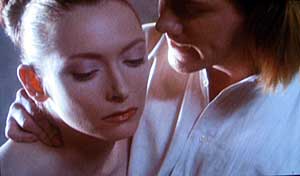 A
few charges of misogyny were leveled against Jarman for his monstrous depiction
of Queen Isabella. The Queen, for example, was not Kent's executioner in
Marlow's play nor is there anything to suggest that, as seen in the film,
she would kill him by chomping on his neck like a vampire. These charges,
however, are baseless, when one considers that virtually everyone
in the film is an unpleasant figure motivated by abuses of power. In fact,
it is difficult - even for a queer audience - to not feel
sympathy for Tilda Swinton's Isabella when the King pushes her away in bed.
Besides, isn't there an old saying that says hell hath no fury like a woman
scorned? A
few charges of misogyny were leveled against Jarman for his monstrous depiction
of Queen Isabella. The Queen, for example, was not Kent's executioner in
Marlow's play nor is there anything to suggest that, as seen in the film,
she would kill him by chomping on his neck like a vampire. These charges,
however, are baseless, when one considers that virtually everyone
in the film is an unpleasant figure motivated by abuses of power. In fact,
it is difficult - even for a queer audience - to not feel
sympathy for Tilda Swinton's Isabella when the King pushes her away in bed.
Besides, isn't there an old saying that says hell hath no fury like a woman
scorned? |
|
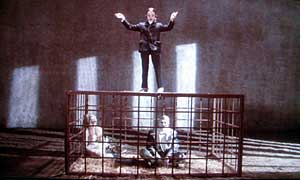 As
Mortimer and Isabella's intrigues against the King become more and more
brazen, Edward III - the King's young son - watches the cruel events unfolding
around him with growing anger and alarm. The boy rejects his warlike toys,
and becomes more and more queer. Marlow's play ends with the young Edward
taking the reigns of power and ordering Mortimer's execution. The film ends
with the boy dressed in a tuxedo and high heels, wearing lipstick, headphones
and large dangling earrings, as he dances to Tchaikovsky's "Dance of the
Sugar Plum Fairies" atop a cage in which Mortimer and his mother sit imprisoned
and chastised. As
Mortimer and Isabella's intrigues against the King become more and more
brazen, Edward III - the King's young son - watches the cruel events unfolding
around him with growing anger and alarm. The boy rejects his warlike toys,
and becomes more and more queer. Marlow's play ends with the young Edward
taking the reigns of power and ordering Mortimer's execution. The film ends
with the boy dressed in a tuxedo and high heels, wearing lipstick, headphones
and large dangling earrings, as he dances to Tchaikovsky's "Dance of the
Sugar Plum Fairies" atop a cage in which Mortimer and his mother sit imprisoned
and chastised. |
|
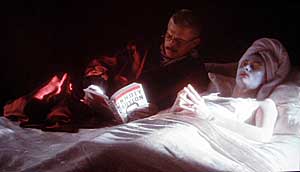 This
is not a stuffy and academic treatise and some of it is even laugh out loud
funny. Just to use one example, I was highly amused by the image of Mortimer
in bed, wearing a smoking jacket and reading a book entitled Unholy Babylon,
while Isabella lays next to him with a towel wrapped around her head and
cold cream all over her face. This grotesque and sitcom-ish parody of the
nuclear family is taken even further as the two bicker while posing, along
with the boy, for an official portrait as an unseen photographer's flashbulbs
light up the screen. The look and feel of Edward
II is so unique that it cannot help but command our attention. This
is not a stuffy and academic treatise and some of it is even laugh out loud
funny. Just to use one example, I was highly amused by the image of Mortimer
in bed, wearing a smoking jacket and reading a book entitled Unholy Babylon,
while Isabella lays next to him with a towel wrapped around her head and
cold cream all over her face. This grotesque and sitcom-ish parody of the
nuclear family is taken even further as the two bicker while posing, along
with the boy, for an official portrait as an unseen photographer's flashbulbs
light up the screen. The look and feel of Edward
II is so unique that it cannot help but command our attention.
|
|
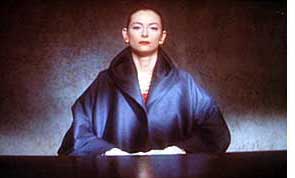 Edward
II is
a difficult but rewarding film. Like Ian
McKellen's 1995 modern dress adaptation of Richard III, it breathes
new life into an old Elizabethan play for a contemporary audience. It is
a gripping re-telling; viewers who might be confused by Caravaggio
will have an easier time following this one's narrative. Jarman's visuals
spring from the eyes of a painter and the acting by all is superb. Tilda
Swinton again is radiant and enigmatic, and will inspire both pity and hatred.
Nigel Terry's Mortimer is such a different character than the one he played
in Caravaggio that it is hard
to believe it is the same actor. Edward
II is
a difficult but rewarding film. Like Ian
McKellen's 1995 modern dress adaptation of Richard III, it breathes
new life into an old Elizabethan play for a contemporary audience. It is
a gripping re-telling; viewers who might be confused by Caravaggio
will have an easier time following this one's narrative. Jarman's visuals
spring from the eyes of a painter and the acting by all is superb. Tilda
Swinton again is radiant and enigmatic, and will inspire both pity and hatred.
Nigel Terry's Mortimer is such a different character than the one he played
in Caravaggio that it is hard
to believe it is the same actor. |
|
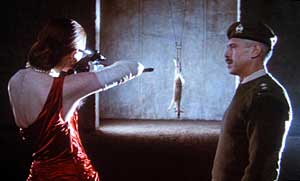 To
some, many of Jarman's embellishments might seem like overkill but one must
take into consideration that this was the work of a very angry and dying
man whose body was being ravaged by AIDS while an uncaring and homophobic
government spoke volumes by its inaction. He had no way of knowing that
he only had three years to live as he filmed Edward
II and he was using the time he had left to solidify his
legacy as a leading subversive, and definitely queer, artist. To
some, many of Jarman's embellishments might seem like overkill but one must
take into consideration that this was the work of a very angry and dying
man whose body was being ravaged by AIDS while an uncaring and homophobic
government spoke volumes by its inaction. He had no way of knowing that
he only had three years to live as he filmed Edward
II and he was using the time he had left to solidify his
legacy as a leading subversive, and definitely queer, artist. |
|
|
Derek Jarman appears
briefly in: Tilda Swinton also
appears in: |